Chapter 14 Reading Quiz Question 9 What Is the Major Product of the Following Reaction?
Chapter 14. Acid-Base Equilibria
14.3 Relative Strengths of Acids and Bases
Learning Objectives
By the cease of this section, you volition exist able to:
- Assess the relative strengths of acids and bases according to their ionization constants
- Rationalize trends in acrid–base strength in relation to molecular construction
- Carry out equilibrium calculations for weak acid–base systems
We can rank the strengths of acids by the extent to which they ionize in aqueous solution. The reaction of an acid with water is given by the full general expression:
[latex]\text{HA}(aq)\;+\;\text{H}_2\text{O}(fifty)\;{\rightleftharpoons}\;\text{H}_3\text{O}^{+}(aq)\;+\;\text{A}^{-}(aq)[/latex]
Water is the base that reacts with the acid HA, A− is the cohabit base of operations of the acid HA, and the hydronium ion is the conjugate acid of water. A strong acrid yields 100% (or very nearly and then) of [latex]\text{H}_3\text{O}^{+}[/latex] and A− when the acrid ionizes in water; Figure 1 lists several strong acids. A weak acid gives small amounts of [latex]\text{H}_3\text{O}^{+}[/latex] and A−.
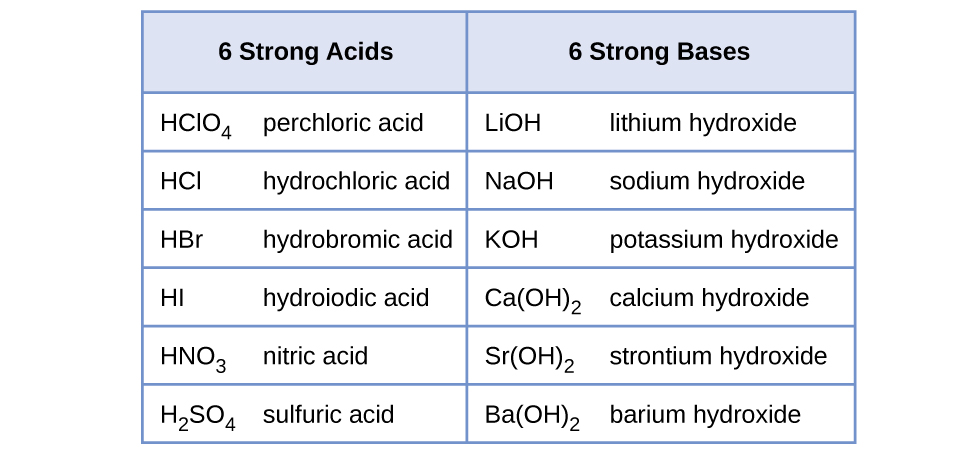
The relative strengths of acids may be determined past measuring their equilibrium constants in aqueous solutions. In solutions of the same concentration, stronger acids ionize to a greater extent, so yield higher concentrations of hydronium ions than do weaker acids. The equilibrium constant for an acid is called the acid-ionization constant, K a . For the reaction of an acid HA:
[latex]\text{HA}(aq)\;+\;\text{H}_2\text{O}(l)\;{\rightleftharpoons}\;\text{H}_3\text{O}^{+}(aq)\;+\;\text{A}^{-}(aq)[/latex],
nosotros write the equation for the ionization abiding equally:
[latex]K_{\text{a}} = \frac{[\text{H}_3\text{O}^{+}][\text{A}^{-}]}{[\text{HA}]}[/latex]
where the concentrations are those at equilibrium. Although water is a reactant in the reaction, information technology is the solvent as well, then we do not include [HtwoO] in the equation. The larger the K a of an acid, the larger the concentration of [latex]\text{H}_3\text{O}^{+}[/latex] and A− relative to the concentration of the nonionized acid, HA. Thus a stronger acid has a larger ionization constant than does a weaker acid. The ionization constants increment as the strengths of the acids increase. (A table of ionization constants of weak acids appears in Appendix H, with a partial listing in Tabular array 2.)
The post-obit information on acid-ionization constants signal the order of acrid strength [latex]\text{CH}_3\text{CO}_2\text{H}\;{\textless}\;\text{HNO}_2\;{\textless}\;\text{HSO}_4^{\;\;-}[/latex]:
[latex]\begin{assortment}{r @{{}\rightleftharpoons{}} ll} \text{CH}_3\text{CO}_2\text{H}(aq)\;+\;\text{H}_2\text{O}(50) & \text{H}_3\text{O}^{+}(aq)\;+\;\text{CH}_3\text{CO}_2^{\;\;-}(aq) & K_{\text{a}} = 1.8\;\times\;10^{-five} \\[0.5em] \text{HNO}_2(aq)\;+\;\text{H}_2\text{O}(l) & \text{H}_3\text{O}^{+}(aq)\;+\;\text{NO}_2^{\;\;-}(aq) & K_{\text{a}} = iv.6\;\times\;10^{-four} \\[0.5em] \text{HSO}_4^{\;\;-}(aq)\;+\;\text{H}_2\text{O}(aq) & \text{H}_3\text{O}^{+}(aq)\;+\;\text{SO}_4^{\;\;2-}(aq) & K_{\text{a}} = 1.2\;\times\;10^{-ii} \stop{assortment}[/latex]
Some other mensurate of the strength of an acrid is its per centum ionization. The percent ionization of a weak acrid is the ratio of the concentration of the ionized acrid to the initial acid concentration, times 100:
[latex]\%\;\text{ionization} = \frac{[\text{H}_3\text{O}^{+}]_{\text{eq}}}{[\text{HA}]_0}\;\times\;100[/latex]
Because the ratio includes the initial concentration, the percentage ionization for a solution of a given weak acid varies depending on the original concentration of the acid, and actually decreases with increasing acid concentration.
Example 1
Calculation of Percent Ionization from pH
Calculate the percent ionization of a 0.125-M solution of nitrous acid (a weak acrid), with a pH of two.09.
Solution
The percent ionization for an acid is:
[latex]\frac{[\text{H}_3\text{O}^{+}]_{\text{eq}}}{[\text{HNO}_2]_0}\;\times\;100[/latex]
The chemic equation for the dissociation of the nitrous acid is: [latex]\text{HNO}_2(aq)\;+\;\text{H}_2\text{O}(l)\;{\rightleftharpoons}\;\text{NO}_2^{\;\;-}(aq)\;+\;\text{H}_3\text{O}^{+}(aq)[/latex]. Since [latex]10^{-\text{pH}} = [\text{H}_3\text{O}^{+}][/latex], we find that 10−two.09 = viii.i × x−three Chiliad, so that per centum ionization is:
[latex]\frac{viii.i\;\times\;10^{-3}}{0.125}\;\times\;100 = vi.5\%[/latex]
Call up, the logarithm 2.09 indicates a hydronium ion concentration with only two pregnant figures.
Cheque Your Learning
Calculate the per centum ionization of a 0.10-Chiliad solution of acerb acrid with a pH of 2.89.
We can rank the strengths of bases by their tendency to course hydroxide ions in aqueous solution. The reaction of a Brønsted-Lowry base of operations with h2o is given past:
[latex]\text{B}(aq)\;+\;\text{H}_2\text{O}(l)\;{\rightleftharpoons}\;\text{HB}^{+}(aq)\;+\;\text{OH}^{-}(aq)[/latex]
Water is the acid that reacts with the base of operations, HB+ is the conjugate acid of the base B, and the hydroxide ion is the conjugate base of water. A potent base yields 100% (or very most and then) of OH− and HB+ when information technology reacts with water; Figure 1 lists several strong bases. A weak base yields a minor proportion of hydroxide ions. Soluble ionic hydroxides such equally NaOH are considered strong bases because they dissociate completely when dissolved in water.

View the simulation of strong and weak acids and bases at the molecular level.
As we did with acids, we tin can measure the relative strengths of bases past measuring their base-ionization abiding (Thou b) in aqueous solutions. In solutions of the aforementioned concentration, stronger bases ionize to a greater extent, and and then yield higher hydroxide ion concentrations than do weaker bases. A stronger base has a larger ionization constant than does a weaker base of operations. For the reaction of a base of operations, B:
[latex]\text{B}(aq)\;+\;\text{H}_2\text{O}(l)\;{\rightleftharpoons}\;\text{HB}^{+}(aq)\;+\;\text{OH}^{-}(aq)[/latex],
we write the equation for the ionization constant as:
[latex]K_{\text{b}} = \frac{[\text{HB}^{+}][\text{OH}^{-}]}{[\text{B}]}[/latex]
where the concentrations are those at equilibrium. Once again, nosotros do not include [H2O] in the equation because water is the solvent. The chemical reactions and ionization constants of the three bases shown are:
[latex]\begin{array}{r @{{}\leftrightharpoons{}} ll} \text{NO}_2^{\;\;-}(aq)\;+\;\text{H}_2\text{O}(l) & \text{HNO}_2(aq)\;+\;\text{OH}^{-}(aq) & K_{\text{b}} = 2.22\;\times\;10^{-11} \\[0.5em] \text{CH}_3\text{CO}_2^{\;\;-}(aq)\;+\;\text{H}_2\text{O}(l) & \text{CH}_3\text{CO}_2\text{H}(aq)\;+\;\text{OH}^{-}(aq) & K_{\text{b}} = 5.6\;\times\;10^{-10} \\[0.5em] \text{NH}_3(aq)\;+\;\text{H}_2\text{O}(l) & \text{NH}_4^{\;\;+}(aq)\;+\;\text{OH}^{-}(aq) & K_{\text{b}} = one.8\;\times\;10^{-5} \stop{array}[/latex]
A table of ionization constants of weak bases appears in Appendix I (with a fractional list in Table 2). As with acids, percent ionization can be measured for basic solutions, just will vary depending on the base ionization constant and the initial concentration of the solution.
Consider the ionization reactions for a cohabit acid-base pair, HA − A−:
[latex]\begin{array}{r @{{}\rightleftharpoons{}} ll} \text{HA}(aq)\;+\;\text{H}_2\text{O}(l) & \text{H}_3\text{O}^{+}(aq)\;+\;\text{A}^{-}(aq) & K_{\text{a}} = \frac{[\text{H}_3\text{O}^{+}][\text{A}^{-}]}{[\text{HA}]} \\[ane.5em] \text{A}^{-}(aq)\;+\;\text{H}_2\text{O}(l) & \text{OH}^{-}(aq)\;+\;\text{HA}(aq) & K_{\text{b}} = \frac{[\text{HA}][\text{OH}]}{[\text{A}^{-}]} \terminate{assortment}[/latex]
Adding these two chemical equations yields the equation for the autoionization for h2o:
[latex]\rule[0.75ex]{3.5em}{0.1ex}\hspace{-3.5em}\text{HA}(aq)\;+\;\text{H}_2\text{O}(fifty)\;+\;\rule[0.75ex]{3.5em}{0.1ex}\hspace{-iii.5em}\text{A}^{-}(aq)\;+\;\text{H}_2\text{O}(l)\;{\leftrightharpoons}\;\text{H}_3\text{O}^{+}(aq)\;+\;\dominion[0.75ex]{three.5em}{0.1ex}\hspace{-3.5em}\text{A}^{-}(aq)\;+\;\text{OH}^{-}(aq)\;+\;\dominion[0.75ex]{iii.5em}{0.1ex}\hspace{-3.5em}\text{HA}(aq)[/latex]
[latex]2\text{H}_2\text{O}(50)\;{\leftrightharpoons}\;\text{H}_3\text{O}^{+}(aq)\;+\;\text{OH}^{-}(aq)[/latex]
As shown in the previous chapter on equilibrium, the Yard expression for a chemical equation derived from adding two or more than other equations is the mathematical product of the other equations' Thou expressions. Multiplying the mass-activity expressions together and cancelling common terms, we see that:
[latex]K_{\text{a}}\;\times\;K_{\text{b}} = \frac{[\text{H}_3\text{O}^{+}][\text{A}^{-}]}{[\text{HA}]}\;\times\;\frac{[\text{HA}][\text{OH}^{-}]}{[\text{A}^{-}]} = [\text{H}_3\text{O}^{+}][\text{OH}^{-}] = K_{\text{w}}[/latex]
For example, the acrid ionization constant of acetic acid (CHiiiCOOH) is 1.8 × 10−5, and the base ionization constant of its conjugate base, acetate ion ([latex]\text{CH}_3\text{COO}^{-}[/latex]), is v.6 × x−10. The product of these two constants is indeed equal to K w:
[latex]K_{\text{a}}\;\times\;K_{\text{b}} = (1.eight\;\times\;10^{-5})\;\times\;(five.half dozen\;\times\;10^{-10}) = one.0\;\times\;10^{-14} = K_{\text{westward}}[/latex]
The extent to which an acid, HA, donates protons to water molecules depends on the strength of the conjugate base, A−, of the acid. If A− is a strong base, any protons that are donated to water molecules are recaptured by A−. Thus there is relatively little A− and [latex]\text{H}_3\text{O}^{+}[/latex] in solution, and the acrid, HA, is weak. If A− is a weak base, water binds the protons more strongly, and the solution contains primarily A− and H3O+—the acid is strong. Stiff acids form very weak cohabit bases, and weak acids form stronger conjugate bases (Figure 2).
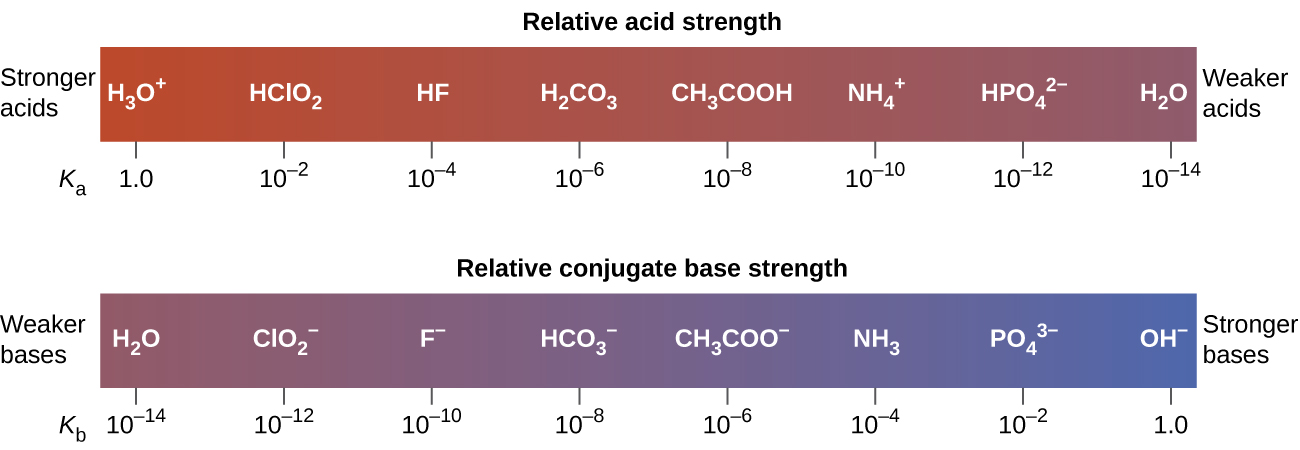
Figure 3 lists a series of acids and bases in order of the decreasing strengths of the acids and the corresponding increasing strengths of the bases. The acrid and base in a given row are conjugate to each other.
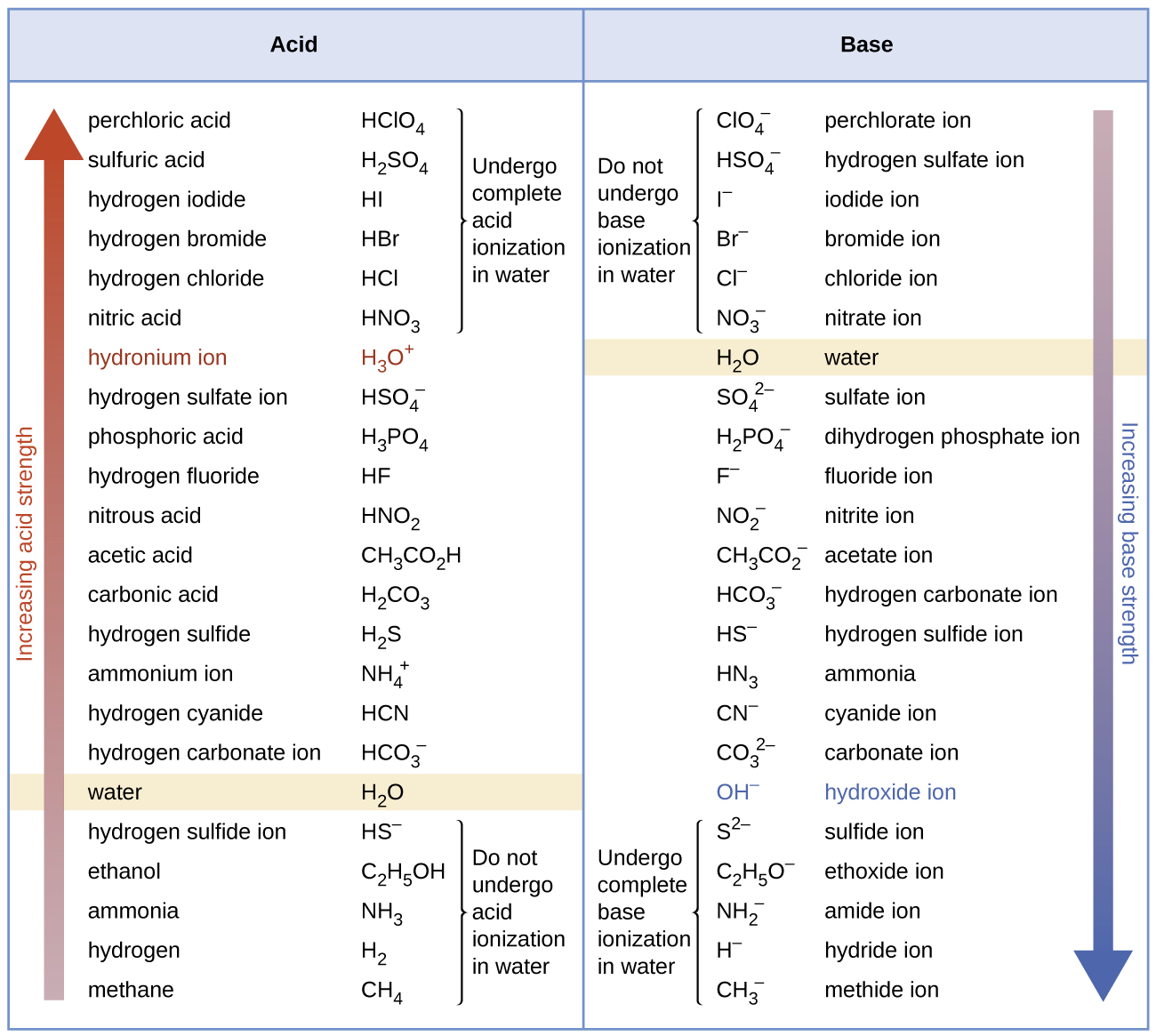
The starting time vi acids in Figure 3 are the virtually common potent acids. These acids are completely dissociated in aqueous solution. The conjugate bases of these acids are weaker bases than h2o. When one of these acids dissolves in water, their protons are completely transferred to water, the stronger base.
Those acids that lie between the hydronium ion and h2o in Figure 3 grade conjugate bases that can compete with water for possession of a proton. Both hydronium ions and nonionized acid molecules are present in equilibrium in a solution of i of these acids. Compounds that are weaker acids than water (those constitute below water in the cavalcade of acids) in Figure 3 exhibit no observable acidic behavior when dissolved in h2o. Their conjugate bases are stronger than the hydroxide ion, and if any conjugate base were formed, information technology would react with h2o to re-class the acid.
The extent to which a base of operations forms hydroxide ion in aqueous solution depends on the strength of the base relative to that of the hydroxide ion, as shown in the last column in Effigy iii. A stiff base, such as one of those lying below hydroxide ion, accepts protons from h2o to yield 100% of the conjugate acid and hydroxide ion. Those bases lying between water and hydroxide ion have protons from water, but a mixture of the hydroxide ion and the base of operations results. Bases that are weaker than water (those that lie in a higher place water in the cavalcade of bases) bear witness no observable basic behavior in aqueous solution.
Example ii
The Product K a×Thou b = K west
Apply the Grand b for the nitrite ion, [latex]\text{NO}_2^{\;\;-}[/latex], to calculate the G a for its conjugate acrid.
Solution
G b for [latex]\text{NO}_2^{\;\;-}[/latex] is given in this section as ii.17 × ten−11. The conjugate acrid of [latex]\text{NO}_2^{\;\;-}[/latex] is HNO2; K a for HNO2 can be calculated using the relationship:
[latex]K_{\text{a}}\;\times\;K_{\text{b}} = ane.0\;\times\;x^{-14} = K_{\text{west}}[/latex]
Solving for K a, we get:
[latex]K_{\text{a}} = \frac{K_{\text{due west}}}{K_{\text{b}}} = \frac{i.0\;\times\;10^{-14}}{2.17\;\times\;10^{-11}} = iv.6\;\times\;ten^{-4}[/latex]
This answer tin be verified by finding the K a for HNOii in Appendix H.
Check Your Learning
We tin decide the relative acid strengths of [latex]\text{NH}_4^{\;\;+}[/latex] and HCN by comparison their ionization constants. The ionization abiding of HCN is given in Appendix H equally 4.9 × 10−10. The ionization constant of [latex]\text{NH}_4^{\;\;+}[/latex] is non listed, but the ionization abiding of its conjugate base, NH3, is listed as 1.viii × ten−v. Decide the ionization constant of [latex]\text{NH}_4^{\;\;+}[/latex], and determine which is the stronger acid, HCN or [latex]\text{NH}_4^{\;\;+}[/latex].
Answer:
[latex]\text{NH}_4^{\;\;+}[/latex] is the slightly stronger acid (K a for [latex]\text{NH}_4^{\;\;+}[/latex] = v.6 × 10−ten).
The Ionization of Weak Acids and Weak Bases
Many acids and bases are weak; that is, they do not ionize fully in aqueous solution. A solution of a weak acid in water is a mixture of the nonionized acid, hydronium ion, and the conjugate base of the acid, with the nonionized acid present in the greatest concentration. Thus, a weak acid increases the hydronium ion concentration in an aqueous solution (but not every bit much equally the same amount of a potent acid).
Acetic acid, CHiiiCO2H, is a weak acid. When we add together acetic acid to water, information technology ionizes to a small extent co-ordinate to the equation:
[latex]\text{CH}_3\text{CO}_2\text{H}(aq)\;+\;\text{H}_2\text{O}(fifty)\;{\leftrightharpoons}\;\text{H}_3\text{O}^{+}(aq)\;+\;\text{CH}_3\text{CO}_2^{\;\;-}(aq)[/latex],
giving an equilibrium mixture with well-nigh of the acid present in the nonionized (molecular) class. This equilibrium, like other equilibria, is dynamic; acerb acrid molecules donate hydrogen ions to water molecules and form hydronium ions and acetate ions at the same rate that hydronium ions donate hydrogen ions to acetate ions to reform acetic acrid molecules and h2o molecules. We tin can tell past measuring the pH of an aqueous solution of known concentration that only a fraction of the weak acrid is ionized at any moment (Effigy 4). The remaining weak acid is present in the nonionized form.
For acetic acid, at equilibrium:
[latex]K_{\text{a}} = \frac{[\text{H}_3\text{O}^{+}][\text{CH}_3\text{CO}_2^{\;\;-}]}{[\text{CH}_3\text{CO}_2\text{H}]} = i.8\;\times\;x^{-5}[/latex]
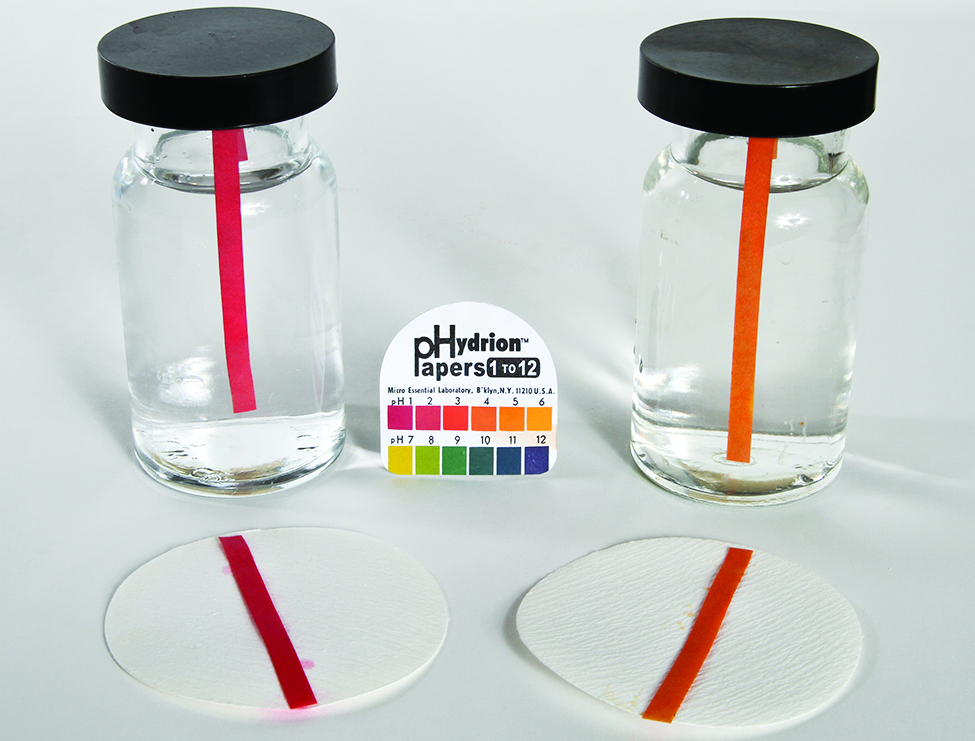
| Ionization Reaction | Yard a at 25 °C |
|---|---|
| [latex]\text{HSO}_4^{\;\;-}\;+\;\text{H}_2\text{O}\;{\rightleftharpoons}\;\text{H}_3\text{O}^{+}\;+\;\text{SO}_4^{\;\;2-}[/latex] | 1.ii × 10−2 |
| [latex]\text{HF}\;+\;\text{H}_2\text{O}\;{\rightleftharpoons}\;\text{H}_3\text{O}^{+}\;+\;\text{F}^{-}[/latex] | iii.v × 10−iv |
| [latex]\text{HNO}_2\;+\;\text{H}_2\text{O}\;{\rightleftharpoons}\;\text{H}_3\text{O}^{+}\;+\;\text{NO}_2^{\;\;-}[/latex] | iv.half dozen × 10−four |
| [latex]\text{HCNO}\;+\;\text{H}_2\text{O}\;{\rightleftharpoons}\;\text{H}_3\text{O}^{+}\;+\;\text{NCO}^{-}[/latex] | 2 × ten−4 |
| [latex]\text{HCO}_2\text{H}\;+\;\text{H}_2\text{O}\;{\rightleftharpoons}\;\text{H}_3\text{O}^{+}\;+\;\text{HCO}_2^{\;\;-}[/latex] | 1.viii × x−four |
| [latex]\text{CH}_3\text{CO}_2\text{H}\;+\;\text{H}_2\text{O}\;{\rightleftharpoons}\;\text{H}_3\text{O}^{+}\;+\;\text{CH}_3\text{CO}_2^{\;\;-}[/latex] | ane.8 × 10−5 |
| [latex]\text{HCIO}\;+\;\text{H}_2\text{O}\;{\rightleftharpoons}\;\text{H}_3\text{O}^{+}\;+\;\text{CIO}^{-}[/latex] | 2.9 × 10−8 |
| [latex]\text{HBrO}\;+\;\text{H}_2\text{O}\;{\rightleftharpoons}\;\text{H}_3\text{O}^{+}\;+\;\text{BrO}^{-}[/latex] | ii.viii × x−nine |
| [latex]\text{HCN}\;+\;\text{H}_2\text{O}\;{\rightleftharpoons}\;\text{H}_3\text{O}^{+}\;+\;\text{CN}^{-}[/latex] | iv.9 × ten−10 |
| Table ii. Ionization Constants of Some Weak Acids | |
Table two gives the ionization constants for several weak acids; additional ionization constants can be found in Appendix H.
At equilibrium, a solution of a weak base in water is a mixture of the nonionized base, the conjugate acrid of the weak base of operations, and hydroxide ion with the nonionized base present in the greatest concentration. Thus, a weak base increases the hydroxide ion concentration in an aqueous solution (only non every bit much as the same amount of a strong base).
For example, a solution of the weak base trimethylamine, (CH3)3Due north, in water reacts according to the equation:
[latex](\text{CH}_3)_3\text{N}(aq)\;+\;\text{H}_2\text{O}(l)\;{\rightleftharpoons}\;(\text{CH}_3)_3\text{NH}^{+}(aq)\;+\;\text{OH}^{-}(aq)[/latex],
giving an equilibrium mixture with most of the base of operations present as the nonionized amine. This equilibrium is analogous to that described for weak acids.
We can confirm by measuring the pH of an aqueous solution of a weak base of known concentration that only a fraction of the base reacts with water (Figure five). The remaining weak base is present every bit the unreacted form. The equilibrium constant for the ionization of a weak base of operations, K b, is called the ionization abiding of the weak base, and is equal to the reaction caliber when the reaction is at equilibrium. For trimethylamine, at equilibrium:
[latex]K_{\text{b}} = \frac{[(\text{CH}_3)_3\text{NH}^{+}][\text{OH}^{-}]}{[(\text{CH}_3)_3\text{Northward}]}[/latex]
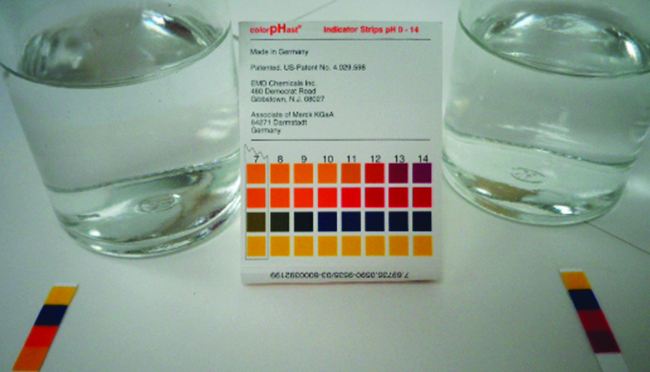
The ionization constants of several weak bases are given in Table 3 and in Appendix I.
| Ionization Reaction | K b at 25 °C |
|---|---|
| [latex](\text{CH}_3)_2\text{NH}\;+\;\text{H}_2\text{O}\;{\rightleftharpoons}\;(\text{CH}_3)_2\text{NH}_2^{\;\;+}\;+\;\text{OH}^{-}[/latex] | v.9 × 10−4 |
| [latex]\text{CH}_3\text{NH}_2\;+\;\text{H}_2\text{O}\;{\rightleftharpoons}\;\text{CH}_3\text{NH}_3^{\;\;+}\;+\;\text{OH}^{-}[/latex] | 4.4 × 10−four |
| [latex](\text{CH}_3)_3\text{N}\;+\;\text{H}_2\text{O}\;{\rightleftharpoons}\;(\text{CH}_3)_3\text{NH}^{+}\;+\;\text{OH}^{-}[/latex] | vi.3 × 10−5 |
| [latex]\text{NH}_3\;+\;\text{H}_2\text{O}\;{\rightleftharpoons}\;\text{NH}_4^{\;\;+}\;+\;\text{OH}^{-}[/latex] | i.8 × 10−v |
| [latex]\text{C}_6\text{H}_5\text{NH}_2\;+\;\text{H}_2\text{O}\;{\rightleftharpoons}\;\text{C}_6\text{N}_5\text{NH}_3^{\;\;+}\;+\;\text{OH}^{-}[/latex] | four.3 × 10−10 |
| Table three. Ionization Constants of Some Weak Bases | |
Case 3
Determination of Thou a from Equilibrium Concentrations
Acetic acid is the principal ingredient in vinegar (Figure 6); that's why it tastes sour. At equilibrium, a solution contains [CHiiiCOtwoH] = 0.0787 M and [latex][\text{H}_3\text{O}^{+}] = [\text{CH}_3\text{CO}_2^{\;\;-}] = 0.00118\;M[/latex]. What is the value of K a for acetic acid?
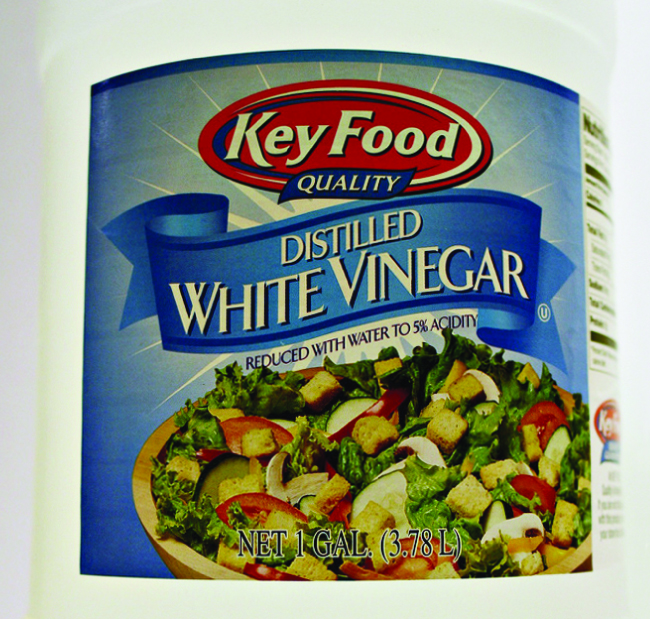
Solution
We are asked to summate an equilibrium constant from equilibrium concentrations. At equilibrium, the value of the equilibrium constant is equal to the reaction quotient for the reaction:
[latex]\text{CH}_3\text{CO}_2\text{H}(aq)\;+\;\text{H}_2\text{O}(fifty)\;{\rightleftharpoons}\;\text{H}_3\text{O}^{+}(aq)\;+\;\text{CH}_3\text{CO}_2^{\;\;-}(aq)[/latex]
[latex]K_{\text{a}} = \frac{[\text{H}_3\text{O}^{+}][\text{CH}_3\text{CO}_2^{\;\;-}]}{[\text{CH}_3\text{CO}_2\text{H}]} = \frac{(0.00118)(0.00118)}{0.0787} = 1.77\;\times\;10^{-5}[/latex]
Cheque Your Learning
What is the equilibrium constant for the ionization of the [latex]\text{HSO}_4^{\;\;-}[/latex] ion, the weak acid used in some household cleansers:
[latex]\text{HSO}_4^{\;\;-}(aq)\;+\;\text{H}_2\text{O}(l)\;{\rightleftharpoons}\;\text{H}_3\text{O}^{+}(aq)\;+\;\text{SO}_4^{\;\;2-}(aq)[/latex]
In one mixture of NaHSO4 and Na2Then4 at equilibrium, [latex][\text{H}_3\text{O}^{+}] = 0.027\;Grand[/latex]; [latex][\text{HSO}_4^{\;\;-}] = 0.29\;K[/latex]; and [latex][\text{Then}_4^{\;\;two-}] = 0.13\;One thousand[/latex].
Reply:
K a for [latex]\text{HSO}_4^{\;\;-} = i.2\;\times\;ten^{-two}[/latex]
Instance 4
Decision of K b from Equilibrium Concentrations
Caffeine, C8H10North4O2 is a weak base. What is the value of K b for caffeine if a solution at equilibrium has [C8HtenN4O2] = 0.050 M, [latex][\text{C}_8\text{H}_{10}\text{N}_4\text{O}_2\text{H}^{+}][/latex] = 5.0 × 10−3 M, and [OH−] = ii.v × ten−3 M?
Solution
At equilibrium, the value of the equilibrium abiding is equal to the reaction caliber for the reaction:
[latex]\text{C}_8\text{H}_{10}\text{N}_4\text{O}_2(aq)\;+\;\text{H}_2\text{O}(l)\;{\rightleftharpoons}\;\text{C}_8\text{H}_{x}\text{N}_4\text{O}_2\text{H}^{+}(aq)\;+\;\text{OH}^{-}(aq)[/latex]
[latex]K_{\text{b}} = \frac{[\text{C}_8\text{H}_{10}\text{N}_4\text{O}_2\text{H}^{+}][\text{OH}^{-}]}{[\text{C}_8\text{H}_{ten}\text{N}_4\text{O}_2]} = \frac{(5.0\;\times\;ten^{-3})(ii.five\;\times\;ten^{-3})}{0.050} = 2.5\;\times\;10^{-4}[/latex]
Cheque Your Learning
What is the equilibrium constant for the ionization of the [latex]\text{HPO}_4^{\;\;two-}[/latex] ion, a weak base:
[latex]\text{HPO}_4^{\;\;2-}(aq)\;+\;\text{H}_2\text{O}(l)\;{\rightleftharpoons}\;\text{H}_2\text{PO}_4^{\;\;-}(aq)\;+\;\text{OH}^{-}(aq)[/latex]
In a solution containing a mixture of NaH2POiv and NatwoHPO4 at equilibrium, [OH−] = one.3 × 10−6 Chiliad; [latex][\text{H}_2\text{PO}_4^{\;\;-}] = 0.042\;Grand[/latex]; and [latex][\text{HPO}_4^{\;\;2-}] = 0.341\;M[/latex].
Answer:
1000 b for [latex]\text{HPO}_4^{\;\;ii-} = 1.6\;\times\;10^{-7}[/latex]
Example 5
Determination of One thousand a or Yard b from pH
The pH of a 0.0516-M solution of nitrous acid, HNOtwo, is two.34. What is its K a?
[latex]\text{HNO}_2(aq)\;+\;\text{H}_2\text{O}(l)\;{\rightleftharpoons}\;\text{H}_3\text{O}^{+}(aq)\;+\;\text{NO}_2^{\;\;-}(aq)[/latex]
Solution
We make up one's mind an equilibrium abiding starting with the initial concentrations of HNOii, [latex]\text{H}_3\text{O}^{+}[/latex], and [latex]\text{NO}_2^{\;\;-}[/latex] as well every bit one of the final concentrations, the concentration of hydronium ion at equilibrium. (Think that pH is merely another way to express the concentration of hydronium ion.)
Nosotros can solve this problem with the following steps in which x is a alter in concentration of a species in the reaction:
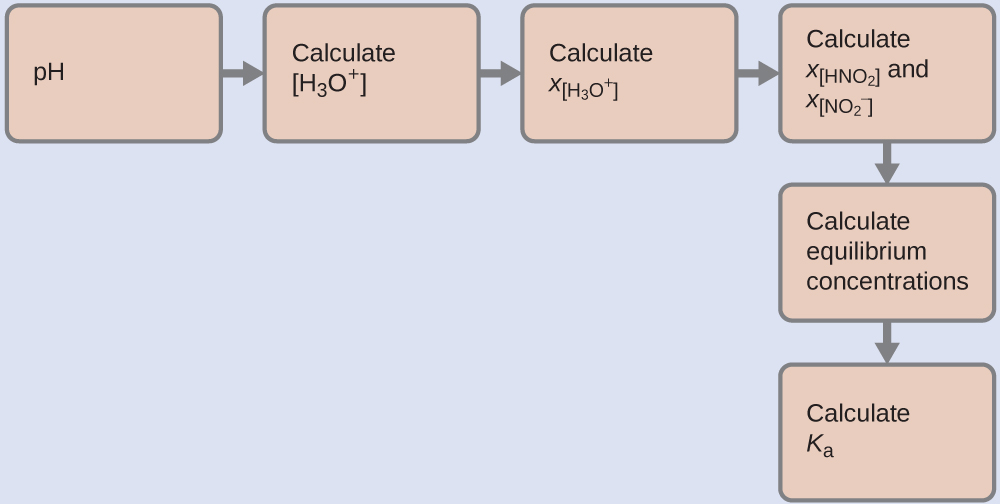
We can summarize the various concentrations and changes as shown hither (the concentration of h2o does not announced in the expression for the equilibrium abiding, so we do non need to consider its concentration):

To get the diverse values in the Water ice (Initial, Modify, Equilibrium) tabular array, we first summate [latex][\text{H}_3\text{O}^{+}][/latex], the equilibrium concentration of [latex]\text{H}_3\text{O}^{+}[/latex], from the pH:
[latex][\text{H}_3\text{O}^{+}] = x^{-ii.34} = 0.0046\;1000[/latex]
The change in concentration of [latex]\text{H}_3\text{O}^{+}[/latex], [latex]x_{[\text{H}_3\text{O}^{+}]}[/latex], is the deviation between the equilibrium concentration of HiiiO+, which we determined from the pH, and the initial concentration, [latex][\text{H}_3\text{O}^{+}]_{\text{i}}[/latex]. The initial concentration of [latex]\text{H}_3\text{O}^{+}[/latex] is its concentration in pure water, which is so much less than the final concentration that we estimate information technology as nothing (~0).
The change in concentration of [latex]\text{NO}_2^{\;\;-}[/latex] is equal to the alter in concentration of [latex][\text{H}_3\text{O}^{+}][/latex]. For each 1 mol of [latex]\text{H}_3\text{O}^{+}[/latex] that forms, 1 mol of [latex]\text{NO}_2^{\;\;-}[/latex] forms. The equilibrium concentration of HNOii is equal to its initial concentration plus the change in its concentration.
Now nosotros tin can fill in the Water ice tabular array with the concentrations at equilibrium, equally shown here:

Finally, nosotros summate the value of the equilibrium constant using the data in the table:
[latex]K_{\text{a}} = \frac{[\text{H}_3\text{O}^{+}][\text{NO}_2^{\;\;-}]}{[\text{HNO}_2]} = \frac{(0.0046)(0.0046)}{(0.0470)} = 4.v\;\times\;10^{-4}[/latex]
Check Your Learning.
The pH of a solution of household ammonia, a 0.950-M solution of NH3, is 11.612. What is K b for NHthree.
Example 6
Equilibrium Concentrations in a Solution of a Weak Acid
Formic acid, HCO2H, is the irritant that causes the body'south reaction to ant stings (Figure 7).
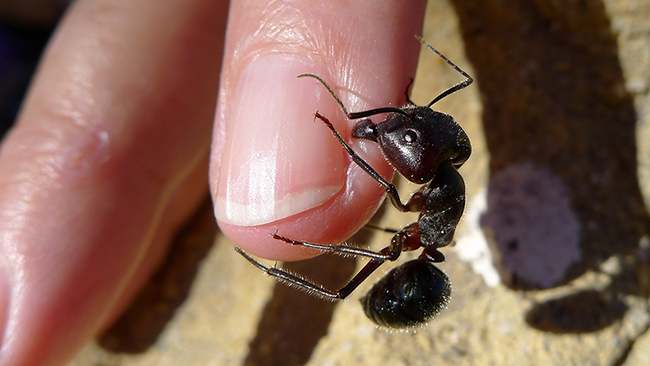
What is the concentration of hydronium ion and the pH in a 0.534-M solution of formic acid?
[latex]\text{HCO}_2\text{H}(aq)\;+\;\text{H}_2\text{O}(50)\;{\rightleftharpoons}\;\text{H}_3\text{O}^{+}(aq)\;+\;\text{HCO}_2^{\;\;-}(aq)\;\;\;\;\;\;\;K_{\text{a}} = ane.eight\;\times\;10^{-four}[/latex]
Solution
- Determine x and equilibrium concentrations. The equilibrium expression is:
[latex]\text{HCO}_2\text{H}(aq)\;+\;\text{H}_2\text{O}(50)\;{\rightleftharpoons}\;\text{H}_3\text{O}^{+}(aq)\;+\;\text{HCO}_2^{\;\;-}(aq)[/latex]
The concentration of water does not appear in the expression for the equilibrium constant, and so we exercise not need to consider its change in concentration when setting up the ICE table.
The table shows initial concentrations (concentrations before the acid ionizes), changes in concentration, and equilibrium concentrations follows (the data given in the problem announced in color):

- Solve for x and the equilibrium concentrations. At equilibrium:
[latex]K_{\text{a}} = i.8\;\times\;10^{-4} = \frac{[\text{H}_3\text{O}^{+}][\text{HCO}_2^{\;\;-}]}{[\text{HCO}_2\text{H}]}[/latex]
[latex]= \frac{(10)(ten)}{0.534\;-\;x} = 1.8\;\times\;10^{-4}[/latex]
Now solve for x. Because the initial concentration of acid is reasonably large and K a is very pocket-sized, we assume that x << 0.534, which permits us to simplify the denominator term as (0.534 − 10) = 0.534. This gives:
[latex]K_{\text{a}} = 1.8\;\times\;x^{-4} = \frac{x^{two+}}{0.534}[/latex]
Solve for x every bit follows:
[latex]ten^{2+} = 0.534\;\times\;(ane.8\;\times\;10^{-4}) = 9.6\;\times\;10^{-v}[/latex]
[latex]10 = \sqrt{ix.half dozen\;\times\;x^{-5}}[/latex]
[latex]= 9.8\;\times\;10^{-3}[/latex]
To bank check the assumption that x is small compared to 0.534, we calculate:
[latex]\frac{x}{0.534} = \frac{9.8\;\times\;10^{-iii}}{0.534} = 1.viii\;\times\;10^{-2}\;(1.8\%\;\text{of}\; 0.534)[/latex]
ten is less than 5% of the initial concentration; the assumption is valid.
We notice the equilibrium concentration of hydronium ion in this formic acid solution from its initial concentration and the modify in that concentration as indicated in the last line of the table:
[latex][\text{H}_3\text{O}^{+}] = {\sim}0\;+\;ten = 0\;+\;nine.eight\;\times\;ten^{-3}\;Grand[/latex].
[latex]= nine.8\;\times\;ten^{-3}\;Thou[/latex]
The pH of the solution can be establish by taking the negative log of the [latex][\text{H}_3\text{O}^{+}][/latex], then:
[latex]-\text{log}(9.8\;\times\;10^{-3}) = 2.01[/latex]
Bank check Your Learning
But a small fraction of a weak acrid ionizes in aqueous solution. What is the percent ionization of acetic acid in a 0.100-G solution of acetic acid, CH3COtwoH?
[latex]\text{CH}_3\text{CO}_2\text{H}(aq)\;+\;\text{H}_2\text{O}(50)\;{\rightleftharpoons}\;\text{H}_3\text{O}^{+}(aq)\;+\;\text{CH}_3\text{CO}_2^{\;\;-}(aq)\;\;\;\;\;\;\;K_{\text{a}} = 1.eight\;\times\;10^{-5}[/latex]
(Hint: Determine [latex][\text{CH}_3\text{CO}_2^{\;\;-}][/latex] at equilibrium.) Think that the percent ionization is the fraction of acetic acid that is ionized × 100, or [latex]\frac{[\text{CH}_3\text{CO}_2^{\;\;-}]}{[\text{CH}_3\text{CO}_2\text{H}]_{\text{initial}}}\;\times\;100[/latex].
Answer:
percent ionization = 1.3%
The post-obit case shows that the concentration of products produced past the ionization of a weak base can be determined by the same series of steps used with a weak acrid.
Example seven
Equilibrium Concentrations in a Solution of a Weak Base of operations
Notice the concentration of hydroxide ion in a 0.25-M solution of trimethylamine, a weak base:
[latex](\text{CH}_3)_3\text{N}(aq)\;+\;\text{H}_2\text{O}(fifty)\;{\rightleftharpoons}\;(\text{CH}_3)_3\text{NH}^{+}(aq)\;+\;\text{OH}^{-}(aq)\;\;\;\;\;\;\;K_{\text{b}} = half-dozen.3\;\times\;10^{-5}[/latex]
Solution
This problem requires that we calculate an equilibrium concentration by determining concentration changes equally the ionization of a base goes to equilibrium. The solution is approached in the same mode as that for the ionization of formic acid in Example 6. The reactants and products volition exist dissimilar and the numbers will be unlike, but the logic volition be the same:

- Determine x and equilibrium concentrations. The table shows the changes and concentrations

- Solve for x and the equilibrium concentrations. At equilibrium:
[latex]K_{\text{b}} = \frac{[(\text{CH}_3)_3\text{NH}^{+}][\text{OH}^{-}]}{[(\text{CH}_3)_3\text{N}]} = \frac{(10)(10)}{0.25\;-\;x} = 6.three\;\times\;10^{-v}[/latex]
If we assume that x is small relative to 0.25, then we can replace (0.25 − ten) in the preceding equation with 0.25. Solving the simplified equation gives:
[latex]ten = four.0\;\times\;10^{-3}[/latex]
This modify is less than 5% of the initial concentration (0.25), then the assumption is justified.
Recall that, for this computation, ten is equal to the equilibrium concentration of hydroxide ion in the solution (meet before tabulation):
[latex][\text{OH}^{-}] = {\sim}0\;+\;x = x = 4.0\;\times\;10^{-3}\;M[/latex]
[latex]= 4.0\;\times\;ten^{-3}\;M[/latex]
So summate pOH as follows:
[latex]\text{pOH} = -\text{log}(4.0\;\times\;10^{-three}) = 2.40[/latex]
Using the relation introduced in the previous section of this chapter:
[latex]\text{pH}\;+\;\text{pOH} = \text{p}K_{\text{w}} = fourteen.00[/latex]
permits the computation of pH:
[latex]\text{pH} = xiv.00\;-\;\text{pOH} = 14.00\;-\;2.forty = eleven.lx[/latex]
- Check the piece of work. A cheque of our arithmetic shows that K b = 6.3 × 10−five.
Check Your Learning
(a) Show that the calculation in Step 2 of this example gives an ten of 4.0 × 10−three and the adding in Footstep iii shows K b = six.iii × 10−5.
(b) Find the concentration of hydroxide ion in a 0.0325-M solution of ammonia, a weak base of operations with a One thousand b of one.76 × 10−5. Calculate the percent ionization of ammonia, the fraction ionized × 100, or [latex]\frac{[\text{NH}_4^{\;\;+}]}{[\text{NH}_3]}\;\times\;100[/latex]
Respond:
7.56 × ten−four M, 2.33%
Some weak acids and weak bases ionize to such an extent that the simplifying assumption that x is small relative to the initial concentration of the acid or base is inappropriate. As we solve for the equilibrium concentrations in such cases, we will see that we cannot neglect the alter in the initial concentration of the acid or base, and we must solve the equilibrium equations by using the quadratic equation.
Instance 8
Equilibrium Concentrations in a Solution of a Weak Acid
Sodium bisulfate, NaHSOfour, is used in some household cleansers because it contains the [latex]\text{HSO}_4^{\;\;-}[/latex] ion, a weak acrid. What is the pH of a 0.50-M solution of HSO4−?HSO4−?
[latex]\text{HSO}_4^{\;\;-}(aq)\;+\;\text{H}_2\text{O}(fifty)\;{\rightleftharpoons}\;\text{H}_3\text{O}^{+}(aq)\;+\;\text{SO}_4^{\;\;two-}(aq)\;\;\;\;\;\;\;K_{\text{a}} = 1.two\;\times\;10^{-ii}[/latex]
Solution
We demand to determine the equilibrium concentration of the hydronium ion that results from the ionization of [latex]\text{HSO}_4^{\;\;-}[/latex] then that nosotros tin use [latex][\text{H}_3\text{O}^{+}][/latex] to determine the pH. Equally in the previous examples, we tin can approach the solution by the post-obit steps:

- Determine x and equilibrium concentrations. This table shows the changes and concentrations:

- Solve for 10 and the concentrations. Every bit we begin solving for x, we volition detect this is more complicated than in previous examples. As we hash out these complications we should not lose track of the fact that it is notwithstanding the purpose of this step to decide the value of x.
At equilibrium:
[latex]K_{\text{a}} = one.2\;\times\;10^{-ii} = \frac{[\text{H}_3\text{O}^{+}][\text{So}_4^{\;\;2-}]}{[\text{HSO}_4^{\;\;-}]} = \frac{(ten)(ten)}{0.50\;-\;ten}[/latex]
If nosotros assume that x is small-scale and approximate (0.l − ten) as 0.50, nosotros notice:
[latex]x = vii.7\;\times\;x^{-two}[/latex]
When we check the assumption, we calculate:
[latex]\frac{x}{[\text{HSO}_4^{\;\;-}]}_{\text{i}}[/latex]
[latex]\frac{x}{0.50} = \frac{7.vii\;\times\;10^{-2}}{0.fifty} = 0.15(fifteen\%)[/latex]
The value of ten is not less than 5% of 0.50, then the assumption is non valid. We need the quadratic formula to discover x.
The equation:
[latex]K_{\text{a}} = 1.two\;\times\;10^{-two} = \frac{(10)(x)}{0.50\;-\;x}[/latex]
gives
[latex]6.0\;\times\;10^{-iii}\;-\;1.ii\;\times\;ten^{-2}ten = ten^{2+}[/latex]
or
[latex]x^{2+}\;+\;ane.2\;\times\;ten^{-2}x\;-\;half dozen.0\;\times\;10^{-3} = 0[/latex]
This equation can be solved using the quadratic formula. For an equation of the grade
[latex]ax^{ii+}\;+\;bx\;+\;c = 0[/latex],
10 is given by the equation:
[latex]x = \frac{-b\;{\pm}\;\sqrt{b^{ii}\;-\;4\text{air conditioning}}}{2a}[/latex]
In this problem, a = one, b = one.2 × 10−three, and c = −6.0 × 10−iii.
Solving for 10 gives a negative root (which cannot be right since concentration cannot exist negative) and a positive root:
[latex]x = 7.2\;\times\;x^{-ii}[/latex]
Now determine the hydronium ion concentration and the pH:
[latex][\text{H}_3\text{O}^{+}] = {\sim}0\;+\;x = 0\;+\;7.ii\;\times\;10^{-2}\;M[/latex]
[latex]= 7.ii\;\times\;10^{-2}\;M[/latex]
The pH of this solution is:
[latex]\text{pH} = -\text{log}[\text{H}_3\text{O}^{+}] = -\text{log}\;7.ii\;\times\;10^{-2} = 1.14[/latex]
Check Your Learning
(a) Prove that the quadratic formula gives ten = 7.2 × 10−two.
(b) Calculate the pH in a 0.010-M solution of caffeine, a weak base:
[latex]\text{C}_8\text{H}_{x}\text{N}_4\text{O}_2(aq)\;+\;\text{H}_2\text{O}(l)\;{\rightleftharpoons}\;\text{C}_8\text{H}_{10}\text{N}_4\text{O}_2\text{H}^{+}(aq)\;+\;\text{OH}^{-}(aq)\;\;\;\;\;\;\;K_{\text{b}} = two.5\;\times\;10^{-4}[/latex]
(Hint: It volition be necessary to catechumen [OH−] to [latex][\text{H}_3\text{O}^{+}][/latex] or pOH to pH toward the cease of the calculation.)
The Relative Strengths of Strong Acids and Bases
Strong acids, such as HCl, HBr, and How-do-you-do, all exhibit the aforementioned forcefulness in h2o. The water molecule is such a stiff base compared to the conjugate bases Cl−, Br−, and I− that ionization of these strong acids is essentially complete in aqueous solutions. In solvents less basic than h2o, we find HCl, HBr, and How-do-you-do differ markedly in their tendency to surrender a proton to the solvent. For example, when dissolved in ethanol (a weaker base than h2o), the extent of ionization increases in the order HCl < HBr < How-do-you-do, and so HI is demonstrated to be the strongest of these acids. The inability to discern differences in force amidst potent acids dissolved in water is known equally the leveling upshot of water.
Water also exerts a leveling consequence on the strengths of strong bases. For example, the oxide ion, O2−, and the amide ion, [latex]\text{NH}_2^{\;\;-}[/latex], are such potent bases that they react completely with h2o:
[latex]\text{O}^{2-}(aq)\;+\;\text{H}_2\text{O}(l)\;{\longrightarrow}\;\text{OH}^{-}(aq)\;+\;\text{OH}^{-}(aq)[/latex]
[latex]\text{NH}_2^{\;\;-}(aq)\;+\;\text{H}_2\text{O}(l)\;{\longrightarrow}\;\text{NH}_3(aq)\;+\;\text{OH}^{-}(aq)[/latex]
Thus, Otwo− and [latex]\text{NH}_2^{\;\;-}[/latex] appear to take the same base strength in water; they both requite a 100% yield of hydroxide ion.
Consequence of Molecular Structure on Acid-Base Strength
In the absence of whatever leveling effect, the acid strength of binary compounds of hydrogen with nonmetals (A) increases equally the H-A bail strength decreases downwards a group in the periodic tabular array. For group 7A, the order of increasing acidity is HF < HCl < HBr < HI. Likewise, for group 6A, the order of increasing acid strength is H2O < HtwoS < H2Se < H2Te.
Across a row in the periodic table, the acrid strength of binary hydrogen compounds increases with increasing electronegativity of the nonmetal atom because the polarity of the H-A bond increases. Thus, the club of increasing acidity (for removal of one proton) across the second row is CHiv < NH3 < H2O < HF; across the tertiary row, it is SiH4 < PH3 < HtwoDue south < HCl (encounter Figure 8).
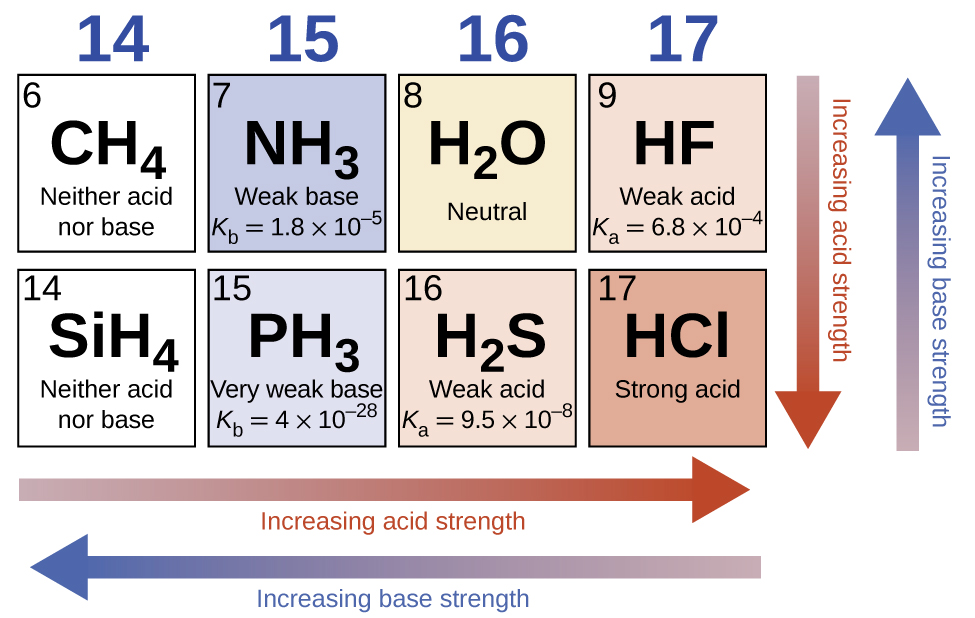
Compounds containing oxygen and one or more than hydroxyl (OH) groups can be acidic, bones, or amphoteric, depending on the position in the periodic tabular array of the central cantlet E, the cantlet bonded to the hydroxyl group. Such compounds have the general formula OnE(OH)thousand, and include sulfuric acid, OtwoDue south(OH)ii, sulfurous acrid, OS(OH)ii, nitric acid, O2NOH, perchloric acid, O3ClOH, aluminum hydroxide, Al(OH)3, calcium hydroxide, Ca(OH)ii, and potassium hydroxide, KOH:
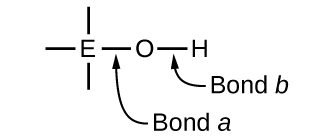
If the central atom, E, has a low electronegativity, its attraction for electrons is low. Little tendency exists for the central atom to grade a strong covalent bail with the oxygen atom, and bond a betwixt the element and oxygen is more readily cleaved than bail b between oxygen and hydrogen. Hence bail a is ionic, hydroxide ions are released to the solution, and the material behaves every bit a base—this is the case with Ca(OH)2 and KOH. Lower electronegativity is characteristic of the more metallic elements; hence, the metal elements form ionic hydroxides that are past definition basic compounds.
If, on the other hand, the atom E has a relatively high electronegativity, it strongly attracts the electrons information technology shares with the oxygen atom, making bond a relatively strongly covalent. The oxygen-hydrogen bond, bond b, is thereby weakened because electrons are displaced toward E. Bond b is polar and readily releases hydrogen ions to the solution, so the material behaves as an acid. High electronegativities are characteristic of the more nonmetallic elements. Thus, nonmetallic elements class covalent compounds containing acidic −OH groups that are chosen oxyacids.
Increasing the oxidation number of the central cantlet East too increases the acerbity of an oxyacid because this increases the attraction of E for the electrons it shares with oxygen and thereby weakens the O-H bail. Sulfuric acid, H2SOiv, or OtwoS(OH)2 (with a sulfur oxidation number of +6), is more than acidic than sulfurous acrid, HiiThen3, or Os(OH)2 (with a sulfur oxidation number of +iv). Likewise nitric acid, HNOthree, or O2NOH (N oxidation number = +v), is more acidic than nitrous acid, HNO2, or ONOH (North oxidation number = +iii). In each of these pairs, the oxidation number of the fundamental atom is larger for the stronger acid (Figure 9).
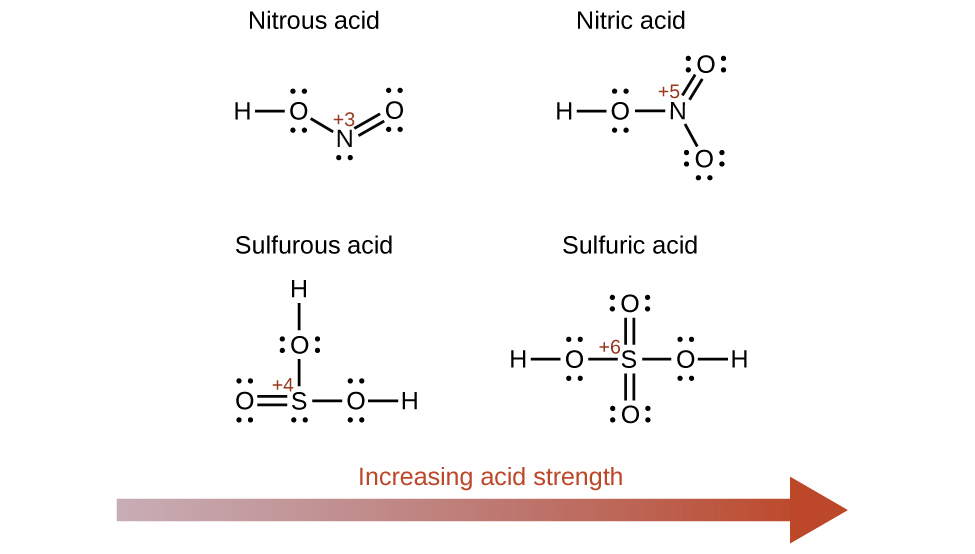
Hydroxy compounds of elements with intermediate electronegativities and relatively high oxidation numbers (for example, elements near the diagonal line separating the metals from the nonmetals in the periodic table) are usually amphoteric. This means that the hydroxy compounds act as acids when they react with stiff bases and as bases when they react with strong acids. The amphoterism of aluminum hydroxide, which commonly exists as the hydrate Al(HiiO)3(OH)3, is reflected in its solubility in both potent acids and strong bases. In strong bases, the relatively insoluble hydrated aluminum hydroxide, Al(H2O)3(OH)iii, is converted into the soluble ion, [latex][\text{Al}(\text{H}_2\text{O})_2(\text{OH})_4]^{-}[/latex], by reaction with hydroxide ion:
[latex]\text{Al}(\text{H}_2\text{O})_3(\text{OH})_3(aq)\;+\;\text{OH}^{-}(aq)\;{\rightleftharpoons}\;\text{H}_2\text{O}(fifty)\;+\;[\text{Al}(\text{H}_2\text{O})_2(\text{OH})_4]^{-}(aq)[/latex]
In this reaction, a proton is transferred from i of the aluminum-bound H2O molecules to a hydroxide ion in solution. The Al(HtwoO)3(OH)3 compound thus acts as an acid under these conditions. On the other paw, when dissolved in strong acids, it is converted to the soluble ion [latex][\text{Al}(\text{H}_2\text{O})_6]^{iii+}[/latex] by reaction with hydronium ion:
[latex]3\text{H}_3\text{O}^{+}(aq)\;+\;\text{Al}(\text{H}_2\text{O})_3(\text{OH})_3(aq)\;{\rightleftharpoons}\;\text{Al}(\text{H}_2\text{O})_6^{\;\;iii+}(aq)\;+\;3\text{H}_2\text{O}(fifty)[/latex]
In this case, protons are transferred from hydronium ions in solution to Al(H2O)3(OH)3, and the compound functions as a base.
Key Concepts and Summary
The strengths of Brønsted-Lowry acids and bases in aqueous solutions can be determined by their acid or base ionization constants. Stronger acids form weaker conjugate bases, and weaker acids form stronger conjugate bases. Thus potent acids are completely ionized in aqueous solution because their conjugate bases are weaker bases than water. Weak acids are simply partially ionized considering their conjugate bases are stiff enough to compete successfully with h2o for possession of protons. Strong bases react with water to quantitatively form hydroxide ions. Weak bases requite only pocket-sized amounts of hydroxide ion. The strengths of the binary acids increment from left to right beyond a period of the periodic table (CH4 < NH3 < H2O < HF), and they increase down a grouping (HF < HCl < HBr < HI). The strengths of oxyacids that contain the same key element increase as the oxidation number of the element increases (H2Then3 < HiiSo4). The strengths of oxyacids also increase as the electronegativity of the key element increases [H2SeO4 < H2SOfour].
Key Equations
- [latex]K_{\text{a}} = \frac{[\text{H}_3\text{O}^{+}][\text{A}^{-}]}{[\text{HA}]}[/latex]
- [latex]K_{\text{b}} = \frac{[\text{HB}^{+}][\text{OH}^{-}]}{[\text{B}]}[/latex]
- [latex]K_{\text{a}}\;\times\;K_{\text{b}} = 1.0\;\times\;10^{-14} = K_{\text{w}}[/latex]
- [latex]\text{Percent\;ionization} = \frac{[\text{H}_3\text{O}^{+}]_{\text{eq}}}{[\text{HA}]_{0}}\;\times\;100[/latex]
Chemical science End of Chapter Exercises
- Explain why the neutralization reaction of a strong acid and a weak base of operations gives a weakly acidic solution.
- Explain why the neutralization reaction of a weak acrid and a strong base gives a weakly basic solution.
- Utilize this list of important industrial compounds (and Effigy 3) to answer the following questions regarding: CaO, Ca(OH)2, CH3CO2H, COii, HCl, H2CO3, HF, HNO2, HNOthree, H3PO4, HtwoSO4, NHiii, NaOH, Na2COthree.
(a) Identify the stiff Brønsted-Lowry acids and strong Brønsted-Lowry bases.
(b) List those compounds in (a) that can behave every bit Brønsted-Lowry acids with strengths lying between those of H3O+ and H2O.
(c) Listing those compounds in (a) that tin acquit every bit Brønsted-Lowry bases with strengths lying between those of H2O and OH−.
- The odour of vinegar is due to the presence of acetic acid, CH3CO2H, a weak acid. List, in order of descending concentration, all of the ionic and molecular species nowadays in a ane-Thou aqueous solution of this acid.
- Household ammonia is a solution of the weak base NHiii in h2o. List, in lodge of descending concentration, all of the ionic and molecular species present in a ane-M aqueous solution of this base of operations.
- Explain why the ionization constant, K a, for HiiSo4 is larger than the ionization abiding for HiiSO3.
- Explain why the ionization constant, Grand a, for Hello is larger than the ionization constant for HF.
- Gastric juice, the digestive fluid produced in the stomach, contains hydrochloric acid, HCl. Milk of Magnesia, a suspension of solid Mg(OH)ii in an aqueous medium, is sometimes used to neutralize backlog stomach acrid. Write a complete balanced equation for the neutralization reaction, and identify the conjugate acid-base pairs.
- Nitric acid reacts with insoluble copper(II) oxide to form soluble copper(2) nitrate, Cu(NOthree)2, a compound that has been used to prevent the growth of algae in swimming pools. Write the balanced chemical equation for the reaction of an aqueous solution of HNO3 with CuO.
- What is the ionization constant at 25 °C for the weak acid [latex]\text{CH}_3\text{NH}_3^{\;\;+}[/latex], the cohabit acid of the weak base CH3NH2, G b = four.four × 10−4.
- What is the ionization constant at 25 °C for the weak acid [latex](\text{CH}_3)_2\text{NH}_2^{\;\;+}[/latex], the cohabit acid of the weak base (CH3)2NH, One thousand b = v.ix × 10−4?
- Which base of operations, CHthreeNH2 or (CH3)2NH, is the stronger base of operations? Which conjugate acid, [latex](\text{CH}_3)_2\text{NH}_2^{\;\;+}[/latex] or (CHthree)iiNH, is the stronger acrid?
- Which is the stronger acid, [latex]\text{NH}_4^{\;\;+}[/latex] or HBrO?
- Which is the stronger base, (CH3)3Northward or [latex]\text{H}_2\text{BO}_3^{\;\;-}[/latex]?
- Predict which acid in each of the post-obit pairs is the stronger and explain your reasoning for each.
(a) HtwoO or HF
(b) B(OH)3 or Al(OH)3
(c) [latex]\text{HSO}_3^{\;\;-}[/latex] or [latex]\text{HSO}_4^{\;\;-}[/latex]
(d) NH3 or H2Due south
(e) HiiO or H2Te
- Predict which compound in each of the following pairs of compounds is more acidic and explain your reasoning for each.
(a) [latex]\text{HSO}_4^{\;\;-}[/latex] or [latex]\text{HSeO}_4^{\;\;-}[/latex]
(b) NHiii or H2O
(c) PH3 or Howdy
(d) NH3 or PH3
(due east) HtwoS or HBr
- Rank the compounds in each of the following groups in guild of increasing acidity or basicity, equally indicated, and explicate the order you assign.
(a) acidity: HCl, HBr, Hello
(b) basicity: H2O, OH−, H−, Cl−
(c) basicity: Mg(OH)two, Si(OH)four, ClO3(OH) (Hint: Formula could also be written every bit HClO4).
(d) acerbity: HF, H2O, NH3, CH4
- Rank the compounds in each of the following groups in social club of increasing acidity or basicity, every bit indicated, and explain the order you lot assign.
(a) acidity: NaHSOthree, NaHSeO3, NaHSO4
(b) basicity: [latex]\text{BrO}_2^{\;\;-}[/latex], [latex]\text{ClO}_2^{\;\;-}[/latex], [latex]\text{IO}_2^{\;\;-}[/latex]
(c) acidity: HOCl, HOBr, HOI
(d) acidity: HOCl, HOClO, HOClOii, HOClO3
(east) basicity: [latex]\text{NH}_2^{\;\;-}[/latex], HS−, HTe−, [latex]\text{PH}_2^{\;\;-}[/latex]
(f) basicity: BrO−, [latex]\text{BrO}_2^{\;\;-}[/latex], [latex]\text{BrO}_3^{\;\;-}[/latex], [latex]\text{BrO}_4^{\;\;-}[/latex]
- Both HF and HCN ionize in h2o to a limited extent. Which of the conjugate bases, F− or CN−, is the stronger base? See Tabular array 3.
- The active ingredient formed by aspirin in the body is salicylic acid, C6H4OH(CO2H). The carboxyl group (−CO2H) acts every bit a weak acid. The phenol group (an OH group bonded to an effluvious ring) also acts every bit an acid just a much weaker acrid. Listing, in lodge of descending concentration, all of the ionic and molecular species nowadays in a 0.001-M aqueous solution of Chalf-dozenH4OH(CO2H).
- What do we represent when we write:
[latex]\text{CH}_3\text{CO}_2\text{H}(aq)\;+\;\text{H}_2\text{O}(fifty)\;{\rightleftharpoons}\;\text{H}_3\text{O}^{+}(aq)\;+\;\text{CH}_3\text{CO}_2^{\;\;-}(aq)[/latex]? - Explicate why equilibrium calculations are not necessary to determine ionic concentrations in solutions of certain strong electrolytes such as NaOH and HCl. Under what weather are equilibrium calculations necessary as office of the conclusion of the concentrations of all ions of some other stiff electrolytes in solution?
- Are the concentrations of hydronium ion and hydroxide ion in a solution of an acid or a base in h2o directly proportional or inversely proportional? Explain your reply.
- What two common assumptions can simplify calculation of equilibrium concentrations in a solution of a weak acid?
- What two mutual assumptions can simplify calculation of equilibrium concentrations in a solution of a weak base?
- Which of the post-obit volition increment the percent of NHiii that is converted to the ammonium ion in h2o (Hint: Use LeChâtelier's principle.)?
(a) addition of NaOH
(b) addition of HCl
(c) addition of NH4Cl
- Which of the following will increment the pct of HF that is converted to the fluoride ion in water?
(a) addition of NaOH
(b) improver of HCl
(c) addition of NaF
- What is the result on the concentrations of NOii −, HNOii, and OH− when the following are added to a solution of KNO2 in h2o:
(a) HCl
(b) HNO2
(c) NaOH
(d) NaCl
(e) KNO
The equation for the equilibrium is:
[latex]\text{NO}_2^{\;\;-}(aq)\;+\;\text{H}_2\text{O}(fifty)\;{\rightleftharpoons}\;\text{HNO}_2(aq)\;+\;\text{OH}^{-}(aq)[/latex]
- What is the event on the concentration of hydrofluoric acid, hydronium ion, and fluoride ion when the post-obit are added to separate solutions of hydrofluoric acid?
(a) HCl
(b) KF
(c) NaCl
(d) KOH
(e) HF
The equation for the equilibrium is:
[latex]\text{HF}(aq)\;+\;\text{H}_2\text{O}(50)\;{\rightleftharpoons}\;\text{H}_3\text{O}^{+}(aq)\;+\;\text{F}^{-}(aq)[/latex]
- Why is the hydronium ion concentration in a solution that is 0.x M in HCl and 0.10 G in HCOOH determined by the concentration of HCl?
- From the equilibrium concentrations given, calculate Yard a for each of the weak acids and K b for each of the weak bases.
(a) CHthreeCOiiH: [latex][\text{H}_3\text{O}^{+}][/latex] = i.34 × ten−3 Yard;
[latex][\text{CH}_3\text{CO}_2^{\;\;-}][/latex] = 1.34 × 10−iii G;
[CHiiiCO2H] = 9.866 × x−2 M;(b) ClO−: [OH−] = iv.0 × 10−four G;
[HClO] = 2.38 × 10−5 Thou;
[ClO−] = 0.273 1000;(c) HCO2H: [HCO2H] = 0.524 M;
[latex][\text{H}_3\text{O}^{+}][/latex] = 9.viii × x−3 Grand;
[latex][\text{HCO}_2^{\;\;-}][/latex] = nine.8 × 10−iii M;(d) [latex]\text{C}_6\text{H}_5\text{NH}_3^{\;\;+}\;\text{:\;}[\text{C}_6\text{H}_5\text{NH}_3^{\;\;+}][/latex] = 0.233 1000;
[Chalf-dozenH5NHtwo] = 2.3 × 10−iii M;
[latex][\text{H}_3\text{O}^{+}][/latex] = 2.3 × 10−iii Grand - From the equilibrium concentrations given, calculate Yard a for each of the weak acids and K b for each of the weak bases.
(a) NH3: [OH−] = 3.1 × 10−3 M;
[latex][\text{NH}_4^{\;\;+}][/latex] = 3.1 × 10−3 M;
[NH3] = 0.533 Chiliad;(b) HNOtwo: [latex][\text{H}_3\text{O}^{+}][/latex] = 0.011 M;
[latex][\text{NO}_2^{\;\;-}][/latex] = 0.0438 M;
[HNOii] = one.07 Chiliad;(c) (CH3)iiiNorth: [(CH3)3North] = 0.25 1000;
[(CH3)threeNH+] = iv.3 × 10−3 One thousand;
[OH−] = 4.iii × x−3 M;(d) [latex]\text{NH}_4^{\;\;+}\;\text{:\;}[\text{NH}_4^{\;\;+}][/latex] = 0.100 Yard;
[NH3] = 7.5 × 10−half dozen K;
[HthreeO+] = 7.5 × 10−six One thousand - Make up one's mind Yard b for the nitrite ion, [latex]\text{NO}_2^{\;\;-}[/latex]. In a 0.ten-G solution this base is 0.0015% ionized.
- Determine K a for hydrogen sulfate ion, [latex]\text{HSO}_4^{\;\;-}[/latex]. In a 0.ten-M solution the acid is 29% ionized.
- Summate the ionization constant for each of the following acids or bases from the ionization constant of its conjugate base of operations or conjugate acrid:
(a) [latex]\text{F}^{-}[/latex]
(b) [latex]\text{NH}_4^{\;\;+}[/latex]
(c) [latex]\text{AsO}_4^{\;\;3-}[/latex]
(d) [latex](\text{CH}_3)_2\text{NH}_2^{\;\;+}[/latex]
(east) [latex]\text{NO}_2^{\;\;-}[/latex]
(f) [latex]\text{HC}_2\text{O}_4^{\;\;-}[/latex] (every bit a base)
- Calculate the ionization constant for each of the following acids or bases from the ionization constant of its cohabit base of operations or conjugate acid:
(a) [latex]\text{HTe}^{-}[/latex] (as a base)
(b) [latex](\text{CH}_3)_3\text{NH}^{+}[/latex]
(c) [latex]\text{HAsO}_4^{\;\;3-}[/latex] (as a base)
(d) [latex]\text{HO}_2^{\;\;-}[/latex] (equally a base)
(e) [latex]\text{C}_6\text{H}_5\text{NH}_3^{\;\;+}[/latex]
(f) [latex]\text{HSO}_3^{\;\;-}[/latex] (every bit a base of operations)
- For which of the following solutions must nosotros consider the ionization of water when computing the pH or pOH?
(a) 3 × 10−eight M HNOiii
(b) 0.ten g HCl in ane.0 Fifty of solution
(c) 0.00080 chiliad NaOH in 0.50 50 of solution
(d) one × ten−7 M Ca(OH)ii
(e) 0.0245 M KNOiii
- Fifty-fifty though both NH3 and CviH5NH2 are weak bases, NHthree is a much stronger acid than CviHfiveNHtwo. Which of the following is correct at equilibrium for a solution that is initially 0.10 Chiliad in NH3 and 0.10 1000 in C6HfiveNHii?
(a) [latex][\text{OH}^{-}] = [\text{NH}_4^{\;\;+}][/latex]
(b) [latex][\text{NH}_4^{\;\;+}] = [\text{C}_6\text{H}_5\text{NH}_3^{\;\;+}][/latex]
(c) [latex][\text{OH}^{-}] = [\text{C}_6\text{H}_5\text{NH}_3^{\;\;+}][/latex]
(d) [latex][\text{NH}_3] = [\text{C}_6\text{H}_5\text{NH}_2][/latex]
(e) both a and b are right
- Calculate the equilibrium concentration of the nonionized acids and all ions in a solution that is 0.25 K in HCO2H and 0.10 M in HClO.
- Calculate the equilibrium concentration of the nonionized acids and all ions in a solution that is 0.134 M in HNOtwo and 0.120 Chiliad in HBrO.
- Calculate the equilibrium concentration of the nonionized bases and all ions in a solution that is 0.25 Thousand in CHthreeNH2 and 0.x M in C5H5Due north (K b = 1.seven × ten−9).
- Calculate the equilibrium concentration of the nonionized bases and all ions in a solution that is 0.115 M in NH3 and 0.100 M in C6H5NHii.
- Using the K a value of 1.4 × 10−5, place [latex]\text{Al}(\text{H}_2\text{O})_6^{\;\;3+}[/latex] in the correct location in Effigy 3.
- Summate the concentration of all solute species in each of the following solutions of acids or bases. Presume that the ionization of h2o can be neglected, and show that the modify in the initial concentrations can be neglected. Ionization constants can be found in Appendix H and Appendix I.
(a) 0.0092 M HClO, a weak acid
(b) 0.0784 M Chalf dozenH5NH2, a weak base of operations
(c) 0.0810 M HCN, a weak acid
(d) 0.11 Yard (CHthree)3N, a weak base
(e) 0.120 Thousand [latex]\text{Iron}(\text{H}_2\text{O})_6^{\;\;2+}[/latex] a weak acrid, K a = 1.6 × 10−seven
- Propionic acid, C2H5CO2H (Thousand a = 1.34 × x−5), is used in the manufacture of calcium propionate, a food preservative. What is the hydronium ion concentration in a 0.698-K solution of C2H5COiiH?
- White vinegar is a 5.0% past mass solution of acetic acid in h2o. If the density of white vinegar is 1.007 chiliad/cmthree, what is the pH?
- The ionization constant of lactic acid, CHiiiCH(OH)CO2H, an acrid found in the blood after strenuous exercise, is 1.36 × 10−four. If 20.0 m of lactic acrid is used to make a solution with a volume of 1.00 L, what is the concentration of hydronium ion in the solution?
- Nicotine, CxH14N2, is a base that volition accept two protons (Thou 1 = 7 × 10−7, K 2 = 1.4 × 10−11). What is the concentration of each species nowadays in a 0.050-K solution of nicotine?
- The pH of a 0.twenty-M solution of HF is ane.92. Make up one's mind K a for HF from these data.
- The pH of a 0.15-Grand solution of [latex]\text{HSO}_4^{\;\;-}[/latex] is 1.43. Decide Thousand a for [latex]\text{HSO}_4^{\;\;-}[/latex] from these data.
- The pH of a 0.10-M solution of caffeine is xi.16. Determine Thousand b for caffeine from these data:
[latex]\text{C}_8\text{H}_{10}\text{N}_4\text{O}_2(aq)\;+\;\text{H}_2\text{O}(l)\;{\leftrightharpoons}\;\text{C}_8\text{H}_{10}\text{N}_4\text{O}_2\text{H}^{+}(aq)\;+\;\text{OH}^{-}(aq)[/latex] - The pH of a solution of household ammonia, a 0.950 M solution of NHthree, is 11.612. Determine 1000 b for NHiii from these data.
Glossary
- acid ionization constant (1000 a)
- equilibrium constant for the ionization of a weak acid
- base of operations ionization constant (K b)
- equilibrium abiding for the ionization of a weak base of operations
- leveling effect of h2o
- whatsoever acid stronger than H3O+, or whatever base of operations stronger than OH− will react with h2o to form HiiiO+, or OH−, respectively; water acts every bit a base to make all potent acids announced equally strong, and it acts equally an acrid to brand all strong bases appear equally strong
- oxyacid
- compound containing a nonmetal and one or more hydroxyl groups
- percent ionization
- ratio of the concentration of the ionized acid to the initial acid concentration, times 100
Solutions
Answers to Chemistry End of Chapter Exercises
2. The salt ionizes in solution, but the anion slightly reacts with water to form the weak acrid. This reaction also forms OH−, which causes the solution to exist basic.
4. [latex][\text{H}_2\text{O}]\;{\textgreater}\;[\text{CH}_3\text{CO}_2\text{H}]\;{\textgreater}\;[\text{H}_3\text{O}^{+}]\;{\approx}\;[\text{CH}_3\text{CO}_2^{\;\;-}]\;{\textgreater}\;[\text{OH}^{-}][/latex]
6. The oxidation state of the sulfur in HiiSO4 is greater than the oxidation country of the sulfur in H2Then3.
8. [latex]\begin{array}{ccccccccc} \text{Mg(OH)}_2(s) & + & 2\text{HCl}(aq) & {\longrightarrow} & \text{Mg}^{2+}(aq) & + & 2\text{Cl}^{-}(aq) & + & 2\text{H}_2\text{O}(fifty) \\[0.5em] \text{BB} & & \text{BA} & & \text{CB} & & \text{CA} & & \end{assortment}[/latex]
x. [latex]K_{\text{a}} = 2.3\;\times\;ten^{-11}[/latex]
12. The stronger base or stronger acid is the ane with the larger K b or K a, respectively. In these two examples, they are (CHiii)iiNH and [latex]\text{CH}_3\text{NH}_3^{\;\;+}[/latex].
14. triethylamine.
sixteen. (a) [latex]\text{HSO}_4^{\;\;-}[/latex]; higher electronegativity of the central ion. (b) H2O; NHiii is a base and water is neutral, or decide on the ground of M a values. (c) How-do-you-do; PH3 is weaker than HCl; HCl is weaker than HI. Thus, PH3 is weaker than HI. (d) PH3; in binary compounds of hydrogen with nonmetals, the acidity increases for the chemical element lower in a group. (e) HBr; in a menstruation, the acidity increases from left to right; in a group, information technology increases from acme to bottom. Br is to the left and beneath S, then HBr is the stronger acid.
xviii. (a) [latex]\text{NaHSeO}_3\;{\textless}\;\text{NaHSO}_3\;{\textless}\;\text{NaHSO}_4[/latex]; in polyoxy acids, the more than electronegative central chemical element—S, in this case—forms the stronger acid. The larger number of oxygen atoms on the fundamental atom (giving it a higher oxidation country) also creates a greater release of hydrogen atoms, resulting in a stronger acid. As a salt, the acidity increases in the aforementioned way. (b) [latex]\text{ClO}_2^{\;\;-}\;{\textless}\;\text{BrO}_2^{\;\;-}\;{\textless}\;\text{IO}_2^{\;\;-}[/latex]; the basicity of the anions in a serial of acids will be the opposite of the acidity in their oxyacids. The acerbity increases every bit the electronegativity of the fundamental atom increases. Cl is more than electronegative than Br, and I is the least electronegative of the 3. (c) [latex]\text{HOI}\;{\textless}\;\text{HOBr}\;{\textless}\;\text{HOCl}[/latex]; in a series of the same form of oxyacids, the acidity increases every bit the electronegativity of the key cantlet increases. Cl is more than electronegative than Br, and I is the least electronegative of the 3. (d) [latex]\text{HOCl}\;{\textless}\;\text{HOClO}\;{\textless}\;\text{HOClO}_2\;{\textless}\;\text{HOClO}_3[/latex]; in a serial of oxyacids of the aforementioned central element, the acidity increases equally the number of oxygen atoms increases (or as the oxidation state of the central atom increases). (e) [latex]\text{HTe}^{-}\;{\textless}\;\text{HS}^{-}\;{\ll}\;\text{PH}_2^{\;\;-}\;{\textless}\;\text{NH}_2^{\;\;-}[/latex]; [latex]\text{PH}_2^{\;\;-}[/latex] and [latex]\text{NH}_2^{\;\;-}[/latex] are anions of weak bases, so they act as strong bases toward H+. HTe− and HS− are anions of weak acids, so they have less basic character. In a periodic group, the more electronegative element has the more basic anion. (f) [latex]\text{BrO}_4^{\;\;-}\;{\textless}\;\text{BrO}_3^{\;\;-}\;{\textless}\;\text{BrO}_2^{\;\;-}\;{\textless}\;\text{BrO}^{-}[/latex]; with a larger number of oxygen atoms (that is, as the oxidation country of the central ion increases), the corresponding acrid becomes more acidic and the anion consequently less basic.
twenty. [latex][\text{H}_2\text{O}]\;{\textgreater}\;[\text{C}_6\text{H}_4\text{OH}(\text{CO}_2\text{H})]\;{\textgreater}\;[\text{H}^{+}]0\;{\textgreater}\;[\text{C}_6\text{H}_4\text{OH}(\text{CO}_2)^{-}]\;{\gg}\;[\text{C}_6\text{H}_4\text{O}(\text{CO}_2\text{H})^{-}]\;{\textgreater}\;[\text{OH}^{-}][/latex]
22. Potent electrolytes are 100% ionized, and, as long every bit the component ions are neither weak acids nor weak bases, the ionic species present result from the dissociation of the strong electrolyte. Equilibrium calculations are necessary when one (or more than) of the ions is a weak acrid or a weak base.
24. 1. Assume that the change in initial concentration of the acrid every bit the equilibrium is established can exist neglected, then this concentration can be assumed constant and equal to the initial value of the total acid concentration. ii. Assume we tin can neglect the contribution of h2o to the equilibrium concentration of H3O+.
26. (b) The addition of HCl
28. (a) Adding HCl volition add HthreeO+ ions, which will then react with the OH− ions, lowering their concentration. The equilibrium will shift to the right, increasing the concentration of HNO2, and decreasing the concentration of [latex]\text{NO}_2^{\;\;-}[/latex] ions. (b) Adding HNOii increases the concentration of HNO2 and shifts the equilibrium to the left, increasing the concentration of [latex]\text{NO}_2^{\;\;-}[/latex] ions and decreasing the concentration of OH− ions. (c) Calculation NaOH adds OH− ions, which shifts the equilibrium to the left, increasing the concentration of [latex]\text{NO}_2^{\;\;-}[/latex] ions and decreasing the concentrations of HNO2. (d) Adding NaCl has no event on the concentrations of the ions. (e) Adding KNO2 adds [latex]\text{NO}_2^{\;\;-}[/latex] ions and shifts the equilibrium to the right, increasing the HNO2 and OH− ion concentrations.
xxx. This is a example in which the solution contains a mixture of acids of different ionization strengths. In solution, the HCO2H exists primarily as HCO2H molecules because the ionization of the weak acrid is suppressed by the strong acrid. Therefore, the HCO2H contributes a negligible amount of hydronium ions to the solution. The stronger acrid, HCl, is the ascendant producer of hydronium ions because it is completely ionized. In such a solution, the stronger acid determines the concentration of hydronium ions, and the ionization of the weaker acrid is fixed by the [HiiiO+] produced by the stronger acrid.
32. (a) [latex]K_{\text{b}} = 1.viii\;\times\;x^{-v}[/latex];
(b) [latex]K_{\text{a}} = iv.5\;\times\;x^{-4}[/latex];
(c) [latex]K_{\text{b}} = 7.iv\;\times\;x^{-5}[/latex];
(d) [latex]K_{\text{a}} = v.half dozen\;\times\;10^{-10}[/latex]
34. [latex]K_{\text{a}} = 1.2\;\times\;10^{-2}[/latex]
36. (a) [latex]K_{\text{b}} = 4.iii\;\times\;10^{-12}[/latex];
(b) [latex]K_{\text{a}} = 1.6\;\times\;ten^{-eight}[/latex];
(c) [latex]K_{\text{b}} = five.9\;\times\;10^{-7}[/latex];
(d) [latex]K_{\text{b}} = 4.2\;\times\;ten^{-3}[/latex];
(due east) [latex]K_{\text{b}} = ii.iii\;\times\;10^{-3}[/latex];
(f) [latex]K_{\text{b}} = 6.iii\;\times\;10^{-thirteen}[/latex]
38. (a) is the right statement.
xl. [H3O+] = 7.5 × 10−3 K
[HNO2] = 0.127
[OH−] = 1.3 × 10−12 Chiliad
[BrO−] = 4.five × 10−viii M
[HBrO] = 0.120 K
42. [OH−] = [latex][\text{NO}_4^{\;\;+}][/latex] = 0.0014 M
[NH3] = 0.144 M
[HthreeO+] = 6.nine × x−12 M
[latex][\text{C}_6\text{H}_5\text{NH}_3^{\;\;+}][/latex] = 3.9 × 10−8 M
[Chalf dozenHfiveNH2] = 0.100 M
44. (a) [latex]\frac{[\text{H}_3\text{O}^{+}][\text{ClO}^{-}]}{[\text{HClO}]} = \frac{(x)(10)}{(0.0092\;-\;ten)}\;{\approx}\;\frac{(ten)(x)}{0.0092} = 2.nine\;\times\;x^{-viii}[/latex]
Solving for x gives 1.63 × 10−five One thousand. This value is less than 5% of 0.0092, and so the supposition that it tin exist neglected is valid. Thus, the concentrations of solute species at equilibrium are:
[H3O+] = [ClO] = 5.8 × 10−v Grand
[HClO] = 0.00092 M
[OH−] = 6.1 × 10−x Thou;
(b) [latex]\frac{[\text{C}_6\text{H}_5\text{NH}_3^{\;\;+}][\text{OH}^{-}]}{[\text{C}_6\text{H}_5\text{NH}_2]} = \frac{(x)(x)}{(0.0784\;-\;x)}\;{\approx}\;\frac{(x)(x)}{0.0784} = iv.3\;\times\;10^{-10}[/latex]
Solving for x gives five.81 × 10−half-dozen M. This value is less than v% of 0.0784, so the assumption that it can be neglected is valid. Thus, the concentrations of solute species at equilibrium are:
[latex][\text{CH}_3\text{CO}_2^{\;\;-}][/latex] = [OH−] = 5.8 × 10−6 M
[Chalf dozenHfiveNHii] = 0.00784
[H3O+] = 1.7× 10−9 M;
(c) [latex]\frac{[\text{H}_3\text{O}^{+}][\text{CN}^{-}]}{[\text{HCN}]} = \frac{(x)(10)}{(0.0810\;-\;x)}\;{\approx}\;\frac{(x)(x)}{0.0810} = 4.9\;\times\;ten^{-10}[/latex]
Solving for x gives vi.30 × 10−6 Grand. This value is less than five% of 0.0810, and so the assumption that it tin be neglected is valid. Thus, the concentrations of solute species at equilibrium are:
[H3O+] = [CN−] = half-dozen.3 × 10−6 K
[HCN] = 0.0810 Thou
[OH−] = 1.6 × 10−9 M;
(d) [latex]\frac{[(\text{CH}_3)_3\text{NH}^{+}][\text{OH}^{-}]}{[(\text{CH}_3)_3\text{N}]} = \frac{(x)(x)}{(0.11\;-\;x)}\;{\approx}\;\frac{(x)(ten)}{0.xi} = 6.three\;\times\;10^{-five}[/latex]
Solving for x gives 2.63 × x−3 One thousand. This value is less than 5% of 0.11, so the assumption that information technology can exist neglected is valid. Thus, the concentrations of solute species at equilibrium are:
[(CHiii)3NH+] = [OH−] = two.6 × 10−3 Grand
[(CHiii)3N] = 0.xi M
[H3O+] = 3.8 × ten−12 M;
(eastward) [latex]\frac{[\text{Fe}(\text{H}_2\text{O})_5(\text{OH})^{+}][\text{H}_3\text{O}^{+}]}{[\text{Atomic number 26}(\text{H}_2\text{O})_6^{\;\;2+}]} = \frac{(x)(x)}{(0.120\;-\;10)}\;{\approx}\;\frac{(x)(x)}{0.120} = 1.half dozen\;\times\;ten^{-7}[/latex]
Solving for x gives 1.39 × 10−4 M. This value is less than 5% of 0.120, so the assumption that it can be neglected is valid. Thus, the concentrations of solute species at equilibrium are:
[Atomic number 26(H2O)5(OH)+] = [HiiiO+] = 1.4 × 10−4 One thousand
[latex][\text{Fe}(\text{H}_2\text{O})_6^{\;\;2+}][/latex] = 0.120 Yard
[OH−] = vii.2 × 10−11 Thou
46. pH = ii.41
48. [C10H14N2] = 0.049 M
[C10HfourteenNiiH+] = 1.9 × 10−iv M
[latex][\text{C}_{10}\text{H}_{14}\text{N}_2\text{H}_2^{\;\;ii+}][/latex] = 1.4 × 10−11 1000
[OH−] = i.9 × 10−4 M
[H3O+] = 5.3 × 10−11 1000
50. [latex]K_{\text{a}} = 1.2\;\times\;10^{-2}[/latex]
52. [latex]K_{\text{b}} = i.77\;\times\;10^{-v}[/latex]
Source: https://opentextbc.ca/chemistry/chapter/14-3-relative-strengths-of-acids-and-bases/
0 Response to "Chapter 14 Reading Quiz Question 9 What Is the Major Product of the Following Reaction?"
Postar um comentário